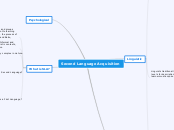For more information about the history and backround of the audiolingual method
Audiolingual Method in the classes
AudiolingualMethod - Hyuleya Mehmed
Teacher's roles
model
monitors and corrects the learners performans
controls the direction and pace of learning
active, the center
students' roles
repeating what teacher says
not encouraged to initiate interaction
little control over the content, pace and style of learning
skills
writing
reading
speaking
listening
classroom materials
tape recorder
microfon
Principals
language is given within a context
language learning is a habit formation
using drills
the purpose is communication
speech is more important than the written form
For more information
Critisism
Negative
there is no production
ss don't have control
teacher centered
not meaningful learning
repeating is boring
memorizing
not natural
ss speak with machines
Positive
meaning is learned in cultural context
improves speaking skills and pronunciation
procedure
10 Follow up activities
9 The students may refer to their textbook
8 Certain key structures from the dialogue are selected and used as basis for pattern drills of different kinds
The dialogue is adapted to the students' interest or situation, through changing certain key words or prases
The students do not consult their books
The dialogue is read aloud, one half saying one speakers part and the other half responding
The dialogue is memorized gradually, line by line
The teacher pays attention to pronunciation, intonation and fluency
SS repeat each line of the dialogue, individually and in chorus
Students first hear a model dialogue
Types of activities
Rejoinder
The student makes an appropriate rejoinder to a given utterance
e.g BE POLITE.
Thank you. - You're welcome.
ANSWER THE QUESTION.
What is your name? - My name is Smith.
Transformation
A sentence is transformed by being made negative or interrogative or through changes in tense, mood, voice, aspect, or modality
e.g He knows my address.
He doesn't know my address.
Does he know my address.
Completion
The students hear an utterance that is complete exept for one word, then repeat the utterance in completed form
e.g I'll go my way and you go ... - I'll go my way and you go yours.
Restatement
The ss rephrases an utterance and addresses it to someone else, according to instructions
e.g Ask her how old she is. - How old are you?
Replacement
One word in an utterance is replaced by another form when repeated
e.g Helen left early. - She left early.
Repetition
The ss repeat an utterance aloud they have heard it
e.g I go to school. - I go to school.









